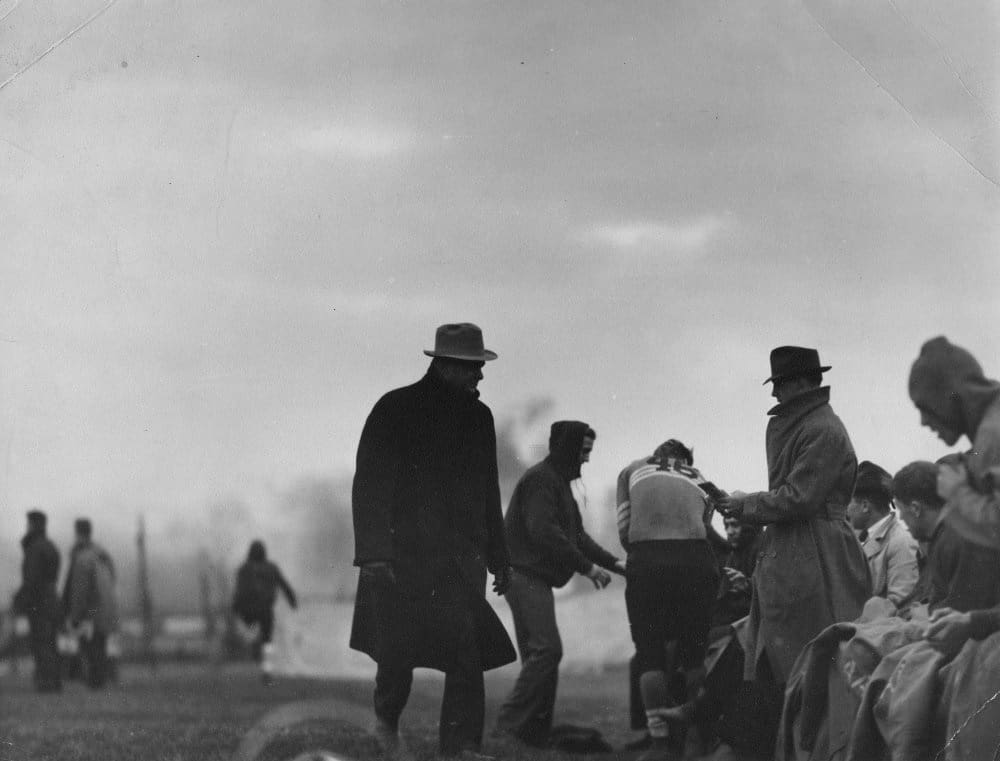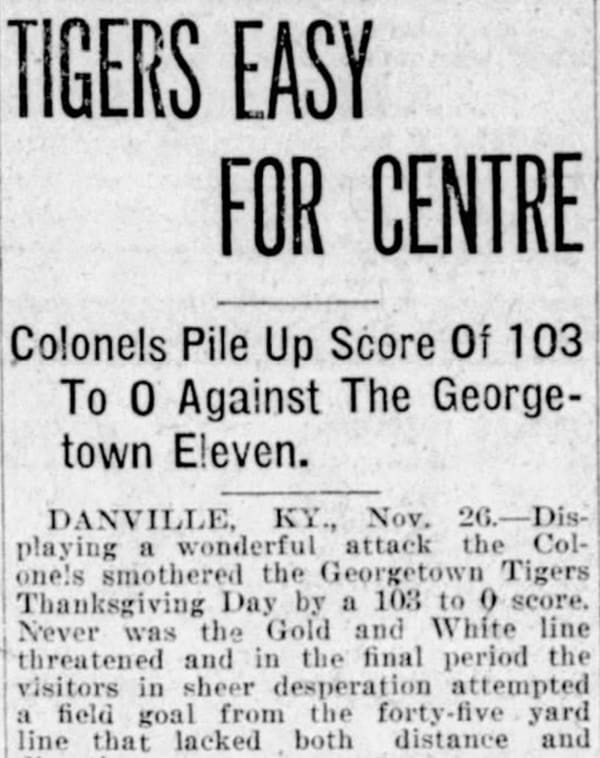The 1920 Regular Season Ends
Georgetown simply couldn't play with Centre anymore. The two colleges had gone their separate ways in the last few years. Georgetown was respectable in 1917, losing by just 13-0. Things had changed dramatically since then with Centre pounding the Tigers 83-3 in 1918 and 77-7 in 1919.
The main interest of the fans in the 1920 Thanksgiving game was whether Red Weaver would get his 100th straight extra point. He had 86. Could the Colonels score 14 touchdowns?
There was no betting on the outcome. A few wagers were made on whether Georgetown would get a first down, or how many, if any. There were few who were willing to put any money on the possibility that the Tigers would score.
The Lexington "Herald" ran a story on the day before the game with the headline:
GEORGETOWN READY FOR SLAUGHTERING
Georgetown goes to Danville Thursday to supply the turkey day feast for the Colonels. It is surely the lamb led to the slaughter this year, for it is conceded that Centre will run up just as many points as she desires.
To accommodate the Colonels in their exhibition, Georgetown will furnish every thrill possible. Their whole play will be directed to slipping over a score of some sort, and every chance will be taken. Their rules in the game will be to take a risk in every play in hope of scoring any way possible, despite the disastrous consequences which may follow.
The capacity crowd which packed Cheek Field on Thanksgiving, 1920, couldn't complain about there being a lack of action. Centre beat the hapless Georgetown team 103-0. The last three contests had a cumulative point total of 263-10. It wasn't a pretty picture.
The Colonels scored 15 touchdowns, averaging a TD every four minutes. Nine men for Centre scored. Each Gold and White who suited up got into the game. The regulars played only the first and third quarters. It didn't really matter who was on the field as Centre scored 28 points in the first quarter and 14 in the second, to lead 42-0 at the break.
The regulars scored 33 points in the third quarter to make it 75-0. The reserves put another 28 on the board in the final period.

On the sideline at Cheek Field during the 103-0 win over Georgetown. Uncle Charlie is consulting with Chief Myers, probably checking to see who hasn't gotten in the game as every Colonel saw action. Hump Tanner is 46.
Uncle Charlie did his best to hold the score down. Once he sent in big Sully Montgomery to fill the quarterback position. He let Red Weaver run the ball several times.
Georgetown made two first downs in the entire game, neither against the starters. In their desperation to score, late in the fourth quarter, the Tigers tried a field goal from the improbable range of 45 yards. They used a holder and he knelt down and placed the ball down a good 10 yards from the center. The kicker got running start, like he was kicking off to start a game. He gave it his all, but the "Messenger" reported that his effort, "lacked both distance and force."

The desperate field goal lacked both "distance and force"
It was a sensitive way to say the ball was ridiculously short.
At the end of the first half, Uncle Charlie didn't even let the team rest but rather entertained the crowd by having his players line up in offensive and defensive positions to compare how plays were run in the early days of football, and how they were run now, since coaches such as himself had opened up the game.
"You see, it was a couple of yards and a cloud of dust," he'd yell into a megaphone when his team ran an old-fashioned, "flying wedge" play.

A "flying wedge" formation which was typical before the game was opened up by the rules changes which made the forward pass legal and other reforms which were championed by participants in a meeting organized by President Theodore Roosevelt in 1905. ( See Chapter 11 )
Then the coach would have his players line up in a similar formation, but Bo would send his ends and a couple of backs down the field and he'd fire a pass to one of them.
"What kind of football is more fun to watch?" Uncle Charlie would ask the crowd.
"Yours, Uncle Charlie! Yours, Uncle Charlie!"
Later, a reporter asked the Centre mentor about the rather different type of halftime entertainment.
Uncle Charlie explained, "There's an effort afoot to try to take the forward pass out of football, or at least effectively kill it."
Moran explained that some of the old traditional coaches in the East felt that football had become more like basketball. "They say that we just run the ball up and down the field like they do in the hoops game. They want a pass, if it isn't completed, to be a free ball, so that anyone can recover it and take possession. Of course, no one would dare pass under those circumstances."
Uncle Charlie continued, "It would ruin the game. It would really ruin Centre. Our attack is built on a wide-open attack. I just wanted the people to see the difference. That's why I held my little drill."
Fortunately, Uncle Charlie was in the majority. Percy Haughton, the legendary Harvard coach from 1908-16, who in his nine seasons had a 71-7-5 record, was pushing to change the rule about the forward pass, but the NCAA rules committee, chaired by Walter Camp, voted him down, much to the relief of everyone who appreciated that a wide open game was what had made college football the most exciting and well attended sport in the nation.
The only disappointing aspect of the game was that Red Weaver's toe was only used four times. Uncle Charlie let Red do the kicking after the first four touchdowns, and he was good on each effort to run his consecutive streak to 90, and then other Colonels took over the kicking.
There was some talk that the coach had been in communication with some of his old friends in Texas, and they had told him that Centre could score at will against TCU in the upcoming post-season game, and he wanted Red to hit 100 in front of his home town supporters in Fort Worth. Of course, we'll never know for certain, but that was the talk at the time.
Even though Uncle Charlie, the Chief and Dr. Ganfield had vowed to always include old traditional opponent and friend, Georgetown, on the Colonels' schedule, the last three games were so one-sided, by a combined score of 263-10, that the Georgetown administration wisely decided to take a breather, and the two colleges didn't meet again on the gridiron until 1925, when Centre, even after the school's glory years, still was too much for the Tigers, and won, 34-6.
